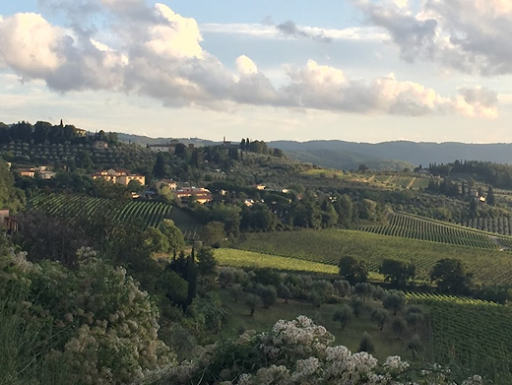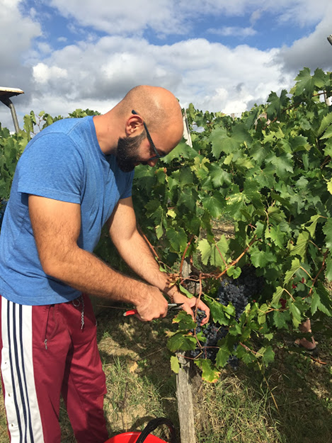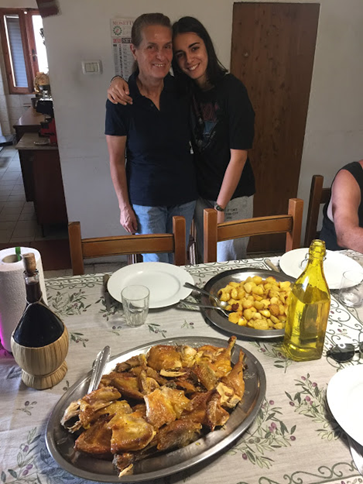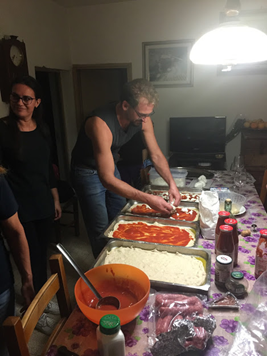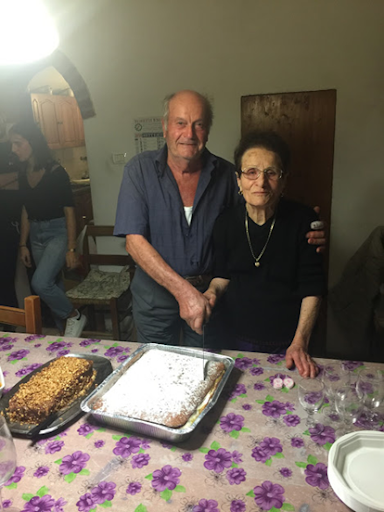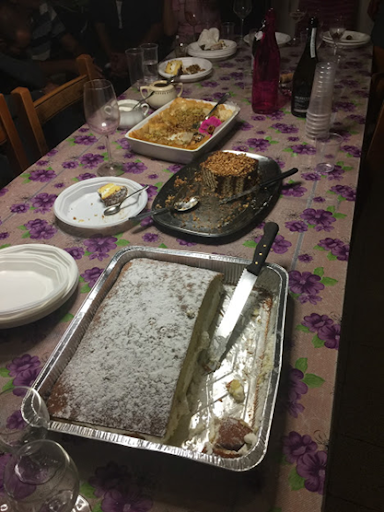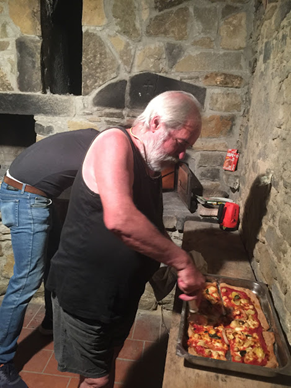Harvest
For the past six years I’ve had the pleasure to cook and serve our guests in Tuscany and drink the wine of the Chianti area. This year was especially exciting because I was invited to help pick the grapes at one of my favorite vineyards: the family vineyard of Montoro e Selove, located in Greve, in the Chianti region. This place has been one of the most favored experiences for the many guests we have hosted in Tuscany. Our guests take a tour of the property and see up close their vines and olive trees. When the family provides our guests with amazing food from their garden and their wonderful Chianti wine, our guests feel fully immersed in the Tuscany culture.
Through the years I’ve become very close to this family and feel very much at home when we visit. It’s fun to bring gifts from our villa “home”. We treat the Montoros with caponata and fresh pasta our guests make in cooking class, and bring a bottle of Chianti Tagefune wine, which is produced at our vineyard at Montepaldi. Our guests are so appreciative and honored to be invited into their charming home and feel a sense of family throughout the experience.
This year on the last visit I was invited to help pick the grapes on the following Sunday to which I jumped at the offer. After all, these past years of walking through the vineyards of Montepaldi and visiting many farms I have never had that experience. I wasn’t going to pass up this opportunity.
It was Sunday morning - the day after a long month of tours. To say the least, I was exhausted, yet very energetic to start the day. After breakfast I journeyed to Greve to this farm just up the hill from the town. As I drove up and down the hills of the countryside, I took in the splendor of the landscape. There was just a hint of the change of season in the hills with withering sunflowers fields and some slight changes in color of the leaves. The trees do not provide the amazing array of colors in the fall like in the northeast of North America, but, this landscape has its own beauty. As far as other motorists, I was all alone. However, there was no shortage of cyclists getting ready for the big race the following weekend in Gaiole in Chianti, no doubt. It’s very common to share the road with cyclists on Sunday and with winter approaching, I’m sure many come out to get their last rides until Spring.
When I arrived at the farm I was greeted by Manuela’s husband, Sergio, and in my simple Italian I asked, “Dove Giovanni e Maurizio?” Sergio pointed in the direction where the tractor was and handed me a set of clippers that were sitting on a bench. The two were not far from the house; father and son picking grapes like they have done for decades before. This time I had the honor to work beside them.
They were in the field of the Canaiolo grapes which will be blended with the Sangiovese to make the Chianti wine. I jumped right in, grabbing a basket and observing how they were clipping the stems of the grapes. The grandson, Enzo, joined us shortly after.
In my row, Maurizio managed the tractor, which supported a big stainless-steel bucket on the back. When we filled our baskets, we dumped the grapes into the bucket. The 86-year-old grandfather, Giovanni, was in the next row. Each time we cleared 10 or so vines, Maurizio moved the tractor forward, so we could continue picking.
Since the tractor was in my row, I could observe Giovanni’s basket full of grapes before they were dumped into the bucket. Although I felt I was holding my own, he always seemed to have a much fuller basket than mine each time I dumped it. He reminded me of my high school best friend’s father, Mr. Casasanta, who has a Christmas tree farm in Kalkaska, Michigan. I remember being amazed by how hard he worked, just like Giovanni, on his farm when I was a teenager. He also taught me how to make fresh pasta in the basement of his home, something I will never forget.
It’s as if hard work in the field is in their DNA. In Giovanni’s case, he was born on this farm and began to work and learn to make wine at an early age. With little more than five years of formal education, this man managed the farm to provide for his family. He also provides the possibility for his son to keep farming, and creates the foundation from which his grandchildren can obtain college degrees.
One grandson, Matteo, went to the University of Florence for wine making. As part of his education he worked at our vineyard, Montepaldi, where the school teaches future winemakers. Currently, Matteo is a junior winemaker at Costello Di Verrazzano, where we visit each year on our Tuscany Dream Tour.
As we continued to pick grapes, I really got an understanding of them. The majority of the vines were full of large clusters of grapes that I estimated to weigh over a pound, while others had just a few or very little at all. Some were so ripe the juices would explode in my hands, painting them a purple color with a sticky coating. The color of my fingers would give evidence of my day in the field for several days after. A small portion of the vines had grape clusters that were dried out looking like raisins, which we disregarded.
The work continued until the tractor bucket was full. Then, we walked behind the tractor as Maurizio drove it to the barn, which had the destemmer and crusher. The bucket contents were slowly dumped into the loud machine that spit out the stems and crushed and pumped the grape musk to a hose toward the large glass lined fiberglass tank. There, it will ferment before being transferred to the barrel or holding tank.
We completed this process twice. Afterwards, we had lunch in the home with several other members of the family. At the table, I sat next to Matteo, who had returned after being one of the cyclists I mentioned earlier. A group of his co-workers from Verrazzano are on a team who will race the following weekend.
At lunch I took delight in the home-cooked roasted chicken, raised from their own coup, with roasted potatoes and beans (fagiolini) which were grown from their garden. Over lunch I had asked Matteo questions about wine-making and picking the grapes:
“Why do some of the vines produce better fruit than others?”
He explained, “It could be the type of soil underneath the vine; maybe there are rocks that make it difficult to grow and seek water. In cases where there were dried-out raisin type of fruit, it could be a fly that landed on the fruit to lay eggs in which case, the fruit gets infected with a fungus. Grapes - like children in a group - ” says Matteo, “when one gets sick the ones around them get sick as well.”
Some varieties of the same type of grapes produce larger berries. “Some of the vines are old. When they are young, they produce large quantities of berries, but as they age, they produce fewer and fewer, however, with better quality,” he says. “Sometimes they make so few grapes, they need to be pruned back substantially so in a few years the new growth will again begin to produce quality fruit.”
When you prune, you have to prune for the present and for the future, making sure you don’t cut the vine shoots that will produce the berries for next year and the following year after.
It was a fascinating lunch as well as delicious. The conclusion of the lunch was adorned by a sweet yellow cake with dried fruit. As we enjoyed our dolce, Matteo’s brother, Enzo, suggested I return in the evening for an 86-birthday party for his grandmother, Bruna. How could I resist? “Absolutely!” I told them I would return with a dessert in hand.
Before lunch ended, I asked if they enjoyed the caponata our guests made for them. They said it was so good the younger members consumed it before the grandparents could have some. I just happened to have a few jars in my car from packing for my next journey, so I ran to the car to retrieve a jar just for Nonna as a birthday gift. She smiled with great joy.
After lunch I drove to the Esulunga, the only store I could think of that would be open on a Sunday afternoon, to buy some items I would need to make a dessert. I would make a Greek dessert, baklava, which my childhood friend Dimitrios taught me many years ago in Sarasota. I had some pasta filo dough, pistachios, butter and sugar back at the Bed and Breakfast, but I needed walnuts, vanilla and honey.
Baklava is very easy to make:
You just layer the filo dough, painting each piece with butter.
Chop up the nuts with a food processor or knife and add cinnamon and nutmeg.
Consider using forno paper to help prevent burning on the bottom of the pan, and to protect the pan when you cut the pieces.
Put 6-8 sheets on the bottom, over the forno paper.
Fill with nuts and cover with 3 more sheets.
Repeat with the nuts and a topping of 6 sheets.
I add chopped pistachios on top for taste and presentation.
Place the pan in the freezer or refrigerator to get the butter on the filo to harden.
Then, take it out and cut the pan into the desired size pieces you want. Filo dough with filling cuts easier when it is cooled. It’s important to cut before you bake because otherwise you will have one crispy piece that will crumble when you cut it.
Place the dish on the bottom oven rack at 350 Fahrenheit and bake for 11 minutes.
While it bakes, reduce while stirring on the stove a cup of water, a half of cup of honey, a cup of sugar and some vanilla. When the top of the baklava is nice and brown and crispy, remove from the oven and pour the hot reduction in the cut lines, filling the pan with sticky goodness. You will hear it sizzle as it hits the hot pan. Yummy!
My dear Bed and Breakfast host, Candida, rounded up some wrapping paper and twine for a bow and a fresh flower was placed in the middle to make a perfect birthday gift.
To say I enjoyed the special birthday celebration would be such an understatement. We feasted on pizzas made in the stone oven outside by a son-in-law who is the chef for a local hotel. The antipasti meats where cut right on the kitchen counter with the families own deli slicer!
I like to consider myself an instigator of a good time, so I begged the often-shy granddaughter Beatrice, to play the violin with her father for her grandmother. This year was the first time I was able to get her to play for our guests and it was amazing. She hemmed and hawed and I even got Matteo to join in to get Beatrice and her father Maurizio to play. They agreed. Before the birthday cake was presented to Nonna, the duet performed a piece from Bach, which brought tears to Nonna’s eyes. I don’t know why, but several of the family members there had never seen the two perform their beautiful talents. Having an amazing piano player as my father, I cherish those memories of him playing at house parties. I guess that is why I was so persistent in getting them to play.
We sang “Happy Birthday” with the cake’s arrival - an out-of-this-world chocolate cake and my baklava flanked the birthday cake, making a trifecta dessert you can only dream about.
There I was, experiencing a special moment across the world. I truly felt like family in their home. I love this family so much. It was a day I will always remember.
Blog Posts


